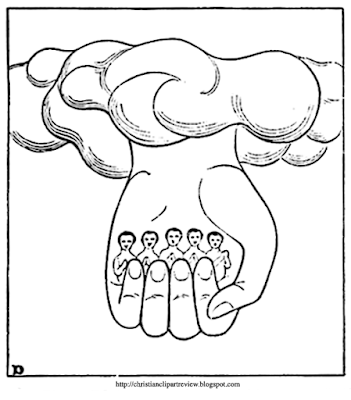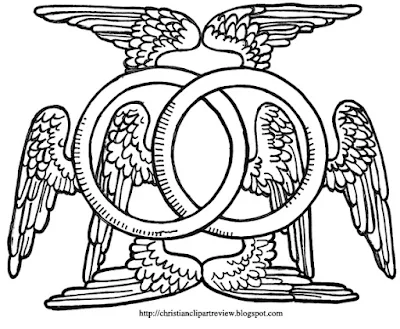 |
Inhabited Cross, Florentine, 1491. All inhabited crosses have one of the
following depicted on them: people, animals and/or villages/cities.
Inhabited crosses look different depending on the culture of the artist
who designs the cross. The above is one of many types. |
The inhabited cross is an ancient variety of this symbol, described by Dante in his Divina Commedia, printed in Florence in 1491. This cross is resplendent with a glory far more radiant then the suns and constellations of every kind which blaze around it. Arriving with Beatrice in the planet Mars, the poet exlaims:
"For with so great a lustre and so red
Splendors appeared tome in twofold rays,
I said: "O Helios who dost so adorn them!"
Even as distinct with less and greater lights
Glimmers between the two poles of the world
The Galaxy that maketh wise men doubt,
Thus constelled in the depths of Mars,
Those rays described the venerable sign
That quadrants joining in a circle make.
Here doth my memory overcome my genius;
For on that cross as levin gleamed forth Christ,
So that I cannot find ensample worthy:
But he who takes his cross and follows Christ,
Again will pardon me what I omit,
Seeing in that aurora lighten Christ.
From horn to horn, and 'twixt the top and base,
Lights were in motion, brightly scintillating
As they together met and passed each other"
Among the twelve little figures inhabiting the cross, representing the souls of valiant warriors, Dante gives the names of eight who occupy the arms of the cross, beginning from left to right. These are Joshua, Judas Maccabaeus, Charlemagne, and Roland in the left arm; and the right, William the Conqueror, Richard Coeur de Lion, Godfrey de Bouillon, and Robert Guiscard. Cacciaguida, and ancestor of the poet, is one of the four souls, not named, who are kneeling in the stem, and upper part of the cross.
"This cross does not contain the Crucified in person, and yet Dante declares that there Christ shone resplendent; in fact, as has been said, the Cross is the symbol of Christ. Iconographically considered, the Son of God is in the Cross, as He is in the Lamb, and in the Lion; He is there hidden under the semblance of the instrument of punishment on which He died. The second Person of the Trinity is figured by an infinite number of different objects: three alone, the Lamb, the Lion, and the Cross, are symbols of our Lord. Even the Fish does not rise to the dignity of a divine symbol." (Didron, Christ. Ion., vol. i., p. 405.)
Scriptural References for Any Inhabited Cross Chrismon:
- "Great is the LORD, and greatly to be praised, In the city of our God,
His holy mountain. Beautiful in elevation, the joy of the whole earth,
Is Mount Zion in the far north, The city of the great King. God, in her
palaces, Has made Himself known as a stronghold." Psalm 48:1-3
- "And I saw the holy city, new Jerusalem, coming down out of heaven from God, made ready as a bride adorned for her husband." Revelation 21:2
- "But as it is, they desire a better country, that is, a heavenly one
Therefore God is not ashamed to be called their God; for He has prepared
a city for them." Hebrews 11:16









































